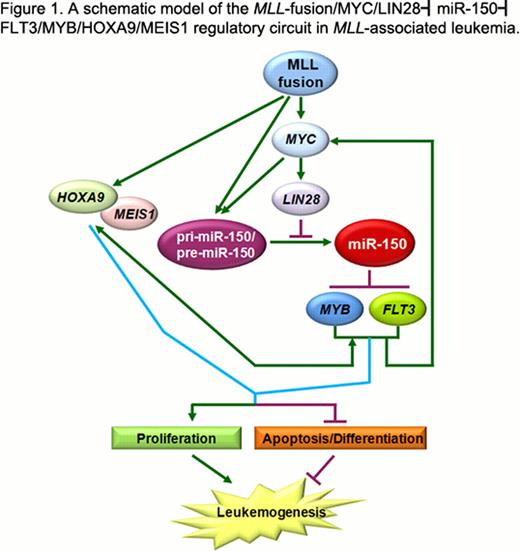Abstract
Abstract 3499
MicroRNAs (miRNAs), a class of small, non-coding RNAs, are important for posttranscriptional gene regulation in both health and disease. Expression of miRNAs is under stringent regulation at both transcriptional and post-transcriptional levels. Disturbance at either level could cause dysregulation of miRNAs. However, though altered expression of many miRNAs has been reported in various cancers, including acute myeloid leukemia (AML), their dysregulational mechanisms and pathologic functions remain less well understood.
Here we report that mature miR-150 level is significantly downregulated in most AML samples, including those with rearrangements of the mixed lineage leukemia (MLL) gene. Strikingly, we found that despite the over 75% decrease of mature miR-150, its primary and precursor transcript abundance is increased to 2∼4 fold in human MLL-associated AML, relative to normal controls. Interestingly, we show that while MLL fusion proteins can bind to the promotor region of miR-150 and promote its primary transcription, they also negatively regulate the maturation process of miR-150 through the MYC/LIN28 functional axis.
MiR-150 has been implicated as either an oncogene or a tumor suppressor in various types of solid tumors. However, its function in the pathogenesis of AML is unknown. Here we showed that ectopic expression of miR-150 dramatically inhibited cell growth and promoted apoptosis of human MLL-associated leukemic cells. Furthermore, using colony-forming/replating assays, we found that co-transduction of miR-150 and MLL-AF9 (a fusion gene resulting from t(9;11)) into mouse bone marrow (BM) progenitor cells, caused a significant reduction in colonies (down to 1∼10%; p<0.001, t-test) compared to transduction of MLL-AF9 alone. More importantly, we performed primary BM transplantation (BMT) assays and found that forced expression of miR-150 significantly delayed leukemogenesis mediated by MLL-AF9 (median overall survival, 110 days versus 56 days; p<0.001, log-rank test). We then performed secondary BMT and showed that miR-150+MLL-AF9 leukemic cells developed AML in secondary recipient mice remarkably slower than MLL-AF9 leukemic cells (median overall survival, 70 days vs. 42 days; p<0.001). These findings suggest that miR-150 plays a critical tumor suppressor role in preventing MLL-associated leukemogenesis. Moreover, through a series of studies, we identified Myb and Flt3 as critical direct targets of miR-150 in cell transformation and leukemogenesis.
Previous studies have shown that there is an autoregulatory feedback loop between FLT3/MYB and HOXA9/MEIS1, and the latter two are critical downstream targets of MLL fusion proteins. In addition, FLT3 has been identified as an upstream regulator of MYC, while MYC is also a downstream target of MLL fusion proteins and an upstream regulator of Lin28. These previous findings together with the data we reported above suggest that there is a critical MLL-fusion/MYC/LIN28-miR-150-FLT3/MYB/HOXA9/MEIS1 regulatory circuit in MLL-associated leukemia (see Fig. 1). In this circuit, MLL fusion proteins function as the driver, and their presence leads to the significant up-regulation of all six downstream genes, MYC, LIN28, FLT3, MYB, HOXA9, and MEIS1, as well as the primary transcription of miR-150. The up-regulation of MYC/LIN28 results in the blockade of the miR-150 maturation process. This in turn leads to the release of miR-150 inhibition on FLT3 and MYB expression, which would enhance the expression of HOXA9, MEIS1, MYC, and LIN28, and further enhance/maintain the blockade of miR-150 maturation. As a result, the cells reach and maintain high levels of MYC/LIN28/FLT3/MYB/HOXA9/MEIS1, and thereby transform the cells and lead to leukemogenesis. Our further systematic studies confirmed the existence/fidelity of this regulatory circuit in MLL-associated leukemia.
Taken together, we revealed a previously unappreciated regulatory circuit. Our findings may advance our understanding of the complex molecular mechanisms underlying the development and maintenance of MLL-associated leukemia, and may also provide new strategies to treat MLL-associated leukemia, a disease that is presently treatment resistant, and likely also other subtypes of AML (as miR-150 is down-regulated in all subtypes of AML), or even other types of cancer that also utilize at least part of the signaling circuit we have described herein.
No relevant conflicts of interest to declare.
Author notes
Asterisk with author names denotes non-ASH members.


This feature is available to Subscribers Only
Sign In or Create an Account Close Modal